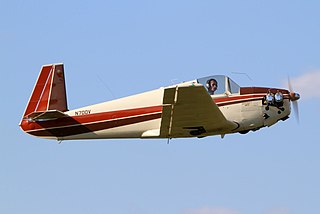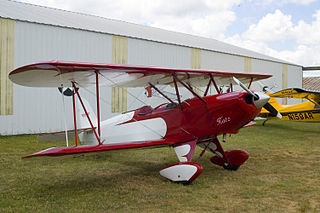Related Research Articles

The Piper PA-24 Comanche is an American four-seat or six-seat, low-wing, all-metal, light aircraft of semimonocoque construction with tricycle retractable landing gear. Piper Aircraft designed and developed the Comanche, which first flew on May 24, 1956. Together with the PA-30 and PA-39 Twin Comanches, it made up the core of the Piper Aircraft lineup until the production lines for both aircraft were destroyed in the 1972 Lock Haven flood.

The Gulfstream American GA-7 Cougar is an American all-metal, 4-seat, twin-engined light aircraft. The Cougar was a twin-engine development of the Gulfstream American AA-5B Tiger and traces its lineage to the AA-1 Yankee Clipper and the Bede BD-1.

The Mooney M-18 "Mite" is a low-wing, single-place monoplane with retractable, tricycle landing gear.

The Diamond DA40 Diamond Star is an Austrian four-seat, single-engine, light aircraft constructed from composite materials. Built in both Austria and Canada, it was developed as a four-seat version of the earlier DA20 by Diamond Aircraft Industries.

The Hatz CB-1 is a 1960s American light biplane designed by John Hatz for amateur construction. The Hatz Classic variant is supplied in kit form by Makelan Corp of New Braunfels, Texas, while the other variants are available as plans only.

The Piper Aerostar is an American twin-engined propeller-driven executive or light transport aircraft, designed by Ted R. Smith. It was originally built by Ted Smith Aircraft Company, which after 1978 became part of the Piper Aircraft Corporation.

The Thurston Teal is a family of two- and four-seat all-aluminium amphibious aircraft designed by David Thurston in the United States and first flown in 1968.
The Davis DA-5, a.k.a. DA-5A, is a single-seat sport aircraft designed in the United States in the 1970s and marketed for homebuilding. Like designer Leeon D. Davis's successful DA-2, it is a low-wing monoplane with fixed tricycle undercarriage and a V-tail, but with a much narrower fuselage accommodating only the pilot, and a lengthened nose. Design work was carried out in 1972, but the prototype was not built until 1974, when it was completed in only 67 days.
The Falconar AMF-S14 Maranda is a two-seat, light aircraft first flown in Canada in 1961 and originally marketed for amateur construction by Falconar Avia.
The Davis DA-1 was a light aircraft designed in the United States in the 1950s which never progressed beyond the prototype stage. Davis tried to bring the plane to market as a certified aircraft, but was not successful.

The Beecraft Queen Bee was an American V-tailed four-seat cabin monoplane, designed and built by Bee Aviation Associates (Beecraft).

The W.A.R. FW-190 is a half-scale homebuilt replica of a Focke-Wulf Fw 190 fighter. In July 1973, War Aircraft Replicas International of Santa Paula, California began design of an approximately half-scale replica of the Fw 190, the first of a series of replicas of World War II aircraft using similar constructional techniques. The first prototype made its maiden flight on 21 August 1974.

The Salvay-Stark Skyhopper I is a low-wing single-place homebuilt aircraft designed in 1944.
The Ra-Son Warrior or X-3 Warrior is a low wing bushplane with a large short coupled tail surface.
The Larsen Special II, is an early homebuilt aircraft that was designed and built in Norway. It was the first homebuilt aircraft to be issued a certificate of airworthiness in Norway.
The Heuberger Sizzler is low-wing, tricycle gear, homebuilt aircraft that was designed by Continental Air Lines engineer Larry Heuberger.
The Aristocraft II was a six-place homebuilt aircraft designed by Terrence O'Neill.
The O'Neill Model J Magnum, also called the Magnum Jake and the Magnum Pickup, is a homebuilt aircraft design for bush flying operations similar to the de Havilland Beaver.
The Shirlen Big Cootie is an American homebuilt biplane that was designed by Roy Shirlen.

The Speedtwin E2E Comet 1, originally named the Phillips ST1 Speedtwin, is a two-seat, twin engined aircraft designed in the UK to be capable of aerobatics and the only civil twin certified for intentional spinning. After a long development time, just two have been built.